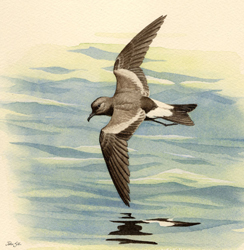Breeding Bird Atlases (BBA)
Find a Bird - BBA1
Breeding Bird Atlas 1 Species Accounts
Leach's Storm-Petrel
Oceanodroma leucorhoa
State Status
Endangered
Egg Dates
June 25 to August 3
Number of Broods
one; may re-lay if first attempt fails.

In eastern North America, the only breeding storm-petrel is the Leach’s. Even though this species is seldom seen by most birders, it is actually one of the most abundant marine birds in the North Atlantic. Colonies of a few to several thousand pairs are located on islands from the British Isles to Newfoundland and south to Muscongus Bay, Maine (formerly to Casco Bay), with a small disjunct colony on Penikese Island in Buzzards Bay.
Leach’s Storm-Petrels were first detected on Penikese Island in 1930. Between 1930 and 1936, only one or two breeding pairs were suspected, but in 1941 State Ornithologist Joseph A. Hagar mapped the locations of 80 nest sites scattered over the island. The first verification of breeding was a nearly fledged chick collected by Hagar on August 24, 1940.
For the next 30 years no published accounts of the petrels on Penikese are available. In 1972, 1 active and 2 inactive burrows were noted; in 1975, 15 to 20 pairs were estimated; and between 1981 and 1985, 5 to 7 pairs were estimated. In July 1984, 5 active burrows were found in a retaining wall, and 21 adults and prebreeding subadults were mist-netted and banded in a two-night period.
In the spring, Leach’s Storm-Petrels arrive at their colony on Penikese Island by the last week in April. Farther north, nest burrows are dug into the ground beneath a canopy of spruce or into sod on treeless islands. On Penikese, the traditional nesting site has been in the crevices of a retaining wall built of large cut stones, but other burrows have been found under building foundations, stone walls, and boulders. Although the loose sandy soil on Penikese may be a relatively easy substrate for storm-petrels to dig in, these burrows, except for those in the retaining wall, do not appear to last for as many years as do those constructed in dense sod on the northern nesting grounds. The nest consists of a few dead seed stalks or blades of grass at the end of the underground burrow.
During the spring and summer, shortly after dark, storm-petrels return to the colony from forays at sea, and the colony becomes alive with activity as birds fly irregular courses low overhead, each bird occasionally breaking the silence with a loud chuckle call. In large colonies, individual calls mingle together to form a loud chorus. From their nesting burrows, the birds emit a repetitious purring or churring call that in the spring may continue for much of the night, interrupted occasionally by the chuckle. As the season progresses and incubation duties begin, the nightly activity over the colony is continued by prebreeders returning from sea for the first time at two or three years of age.
Storm-petrels have a highly developed sense of smell, which enables them to follow scent trails on the open ocean. They can also locate their colony and even their individual burrows by scent as they return on dark, foggy nights.
Although Leach’s Storm-Petrels are about the size of a robin, characteristics of their life history are similar to those of much larger seabird species. They are long-lived (to at least 29 years), the age at first breeding is great (4 to 5 years), the clutch size is small (one very large white egg), the incubation and fledging periods are long (40 to 50 days and 63 to 70 days, respectively), and they tend to mate for life, although fidelity appears to be directed more toward the burrow than the partner.
The egg, and later the chick, is often left unattended because the adults must travel great distances to feed. During these periods, which may last for several days, development in the egg is slowed. Likewise, the chick becomes dormant during the days when it is not fed. Although these periods of neglect cause no apparent harm, the incubation and fledging periods are increased proportionately. Hatching usually begins in mid-July, but in large colonies fledging of the last chicks continues into November and possibly December.
Because the nests on Penikese Island are very difficult to reach, there is little specific nesting data for Massachusetts. An egg was discovered in one nest in the rock wall on July 4. A pipped egg found in a nest on August 2 hatched the following day. Allowing for the minimum incubation period, the egg would have been laid about June 25. The youngster was known to have fledged 61 days after hatching (Hagar). In Maine, nests with eggs have been recorded from June 1 to August 19.
In the fall, the departure of most adults from the colony occurs in September and October and coincides with the period of peak numbers off our coast. Most Massachusetts inland records are of birds driven ashore by storms from late August to early December (most occur in October and November), but a few birds have also been found inland during periods of clear weather.
Off our shores, the Leach’s Storm-Petrel usually feeds in areas of cold upwellings with high plankton densities near the edge of the continental shelf. Most individuals of the Atlantic winter in tropical seas on both sides of the equator.
The Leach’s Storm-Petrel is listed as an endangered species in Massachusetts.
Map Legend and Data Summary
Atlas 1 data collected from 1975-1979


Note: rare and local at Penikese Island, where population has declined since 1940
Thomas W. French



